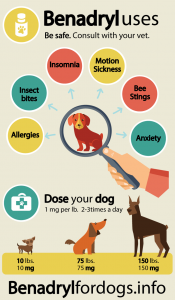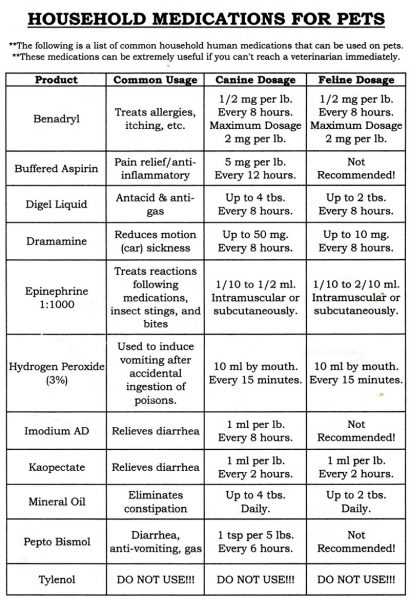
If your dog has mild allergies, you can treat them with over the counter medications intended for humans (people medicine) and avoid the risks and cost of prescription drugs like Prednisone.

There are a number of reasons you might want to give your dog Benedryl (diphenhydramine – also available in many generic brands). Diphenhydramine is an antihistamine, so it helps in relieving itching from contact allergies or bug bites or stings. It can be used to reduce swelling and pain from a snake bite. It will calm a hyperactive dog or reduce “terrors” during fireworks or thunderstorms.
The usual dosage of Diphenhydramine for dogs is 1 mg per pound of dog every 8 to 12 hours (two to three times daily), but a single dose can be doubled to 2mg/lb if needed in an emergency such as a snake bite. This suggested dose is for formulations containing the active ingredient diphenhydramine only — NO Tylenol. Tylenol (acetaminophen) is poisonous to dogs. Overdosing on diphenhydramine for an extended period can be lethal, but there is a wide margin of safety.
If you need something stronger, Cetirizine (Zyrtec) and Loratadine (Claratin) are also safe for canine use and available in affordable generic forms.
Cetirizine comes in tablet form and should be taken orally once a day. For dogs, dosage is based on their overall weight, the ratio being 1 mg of Cetirizine per kilogram (1 KG is 2.2 pounds). Cetirizine has not been proven safe to use in dogs or cats that may be pregnant or nursing. Since Cetirizine is a drug primarily intended for human use, and since there is no veterinarian-approved equivalent, Cetirizine for dogs and cats is considered an extra-label drug, or a drug being used outside its realm of approved use. In other words, use it at your own risk.
NOTE: The above is the “recommended dose” and I would consider it the maximum dose, lower doses are often effective and safer. For instance, Blondie Bear suffers from grass allergies in the summer. To keep her from scratching herself raw I give her a generic form of Zyrtec we get at a dollar store. Blondie weighs 85 pounds. At the above recommended dose I would need to give her 38 mg or two tablets per day. I did that and she became lethargic, even refusing to eat, and had trouble walking. I backed the dosage off and found that 1/2 a tablet (10) morning and evening was enough to quell her itching and allow her to function normally.
When using Loratadine (Claratin) owners should stick to using either the plain formula or the children’s formula. Avoid using Claritin-D which contains the additional ingredient pseudoephedrine. Just 240 mg of pseudoephedrine could be lethal to small dogs and could cause unwanted stimulant-like effects in larger dogs. Loratadine can be given to dogs at a dosage of 0.12 mg/lb to 0.22 mg/lb (0.25 to 0.5 mg/kg) to relieve allergy symptoms. So a 50 pound dog would get 10 mg.
Also avoid the use of any non-drowsy formulation of these drugs.
Other household medications that are safe for your dog or cat include:
Remember, these are stop-gap measures only. For the sake of your pet, get them to a veterinarian as soon as possible for diagnosis and treatment of an on-going illness. Your veterinarian may well say, “continue what you’re doing.” but leave the diagnosis to the professional.
| If you enjoy our updates, Doggy Tales, and educational articles consider subscribing for notices when new pieces are posted. It’s painless and you can unsubscribe any time you want. Your e-mail address is used ONLY to deliver these notices. | [email-subscribers namefield=”YES” desc=”” group=”Public”] |




